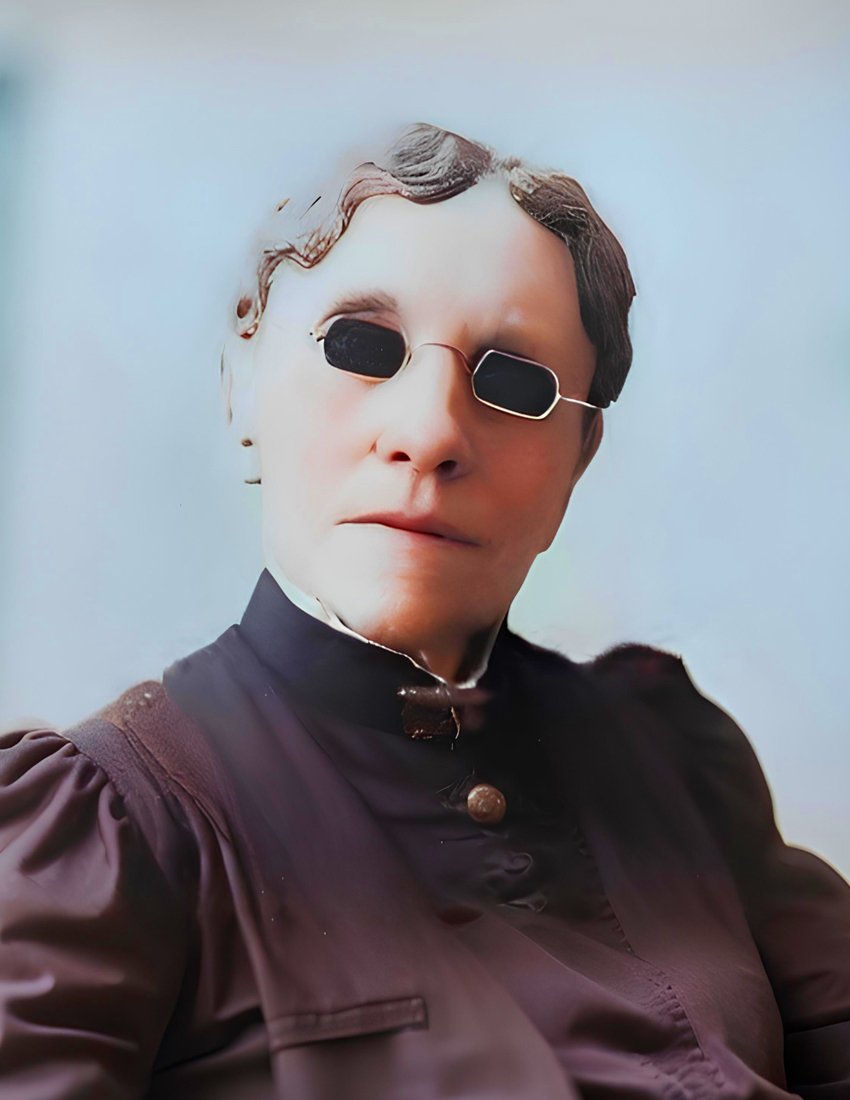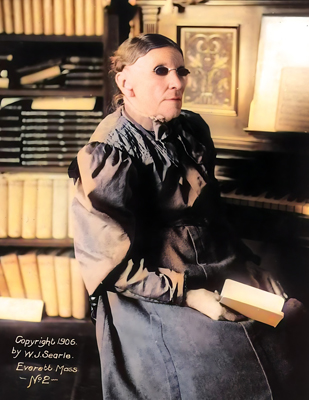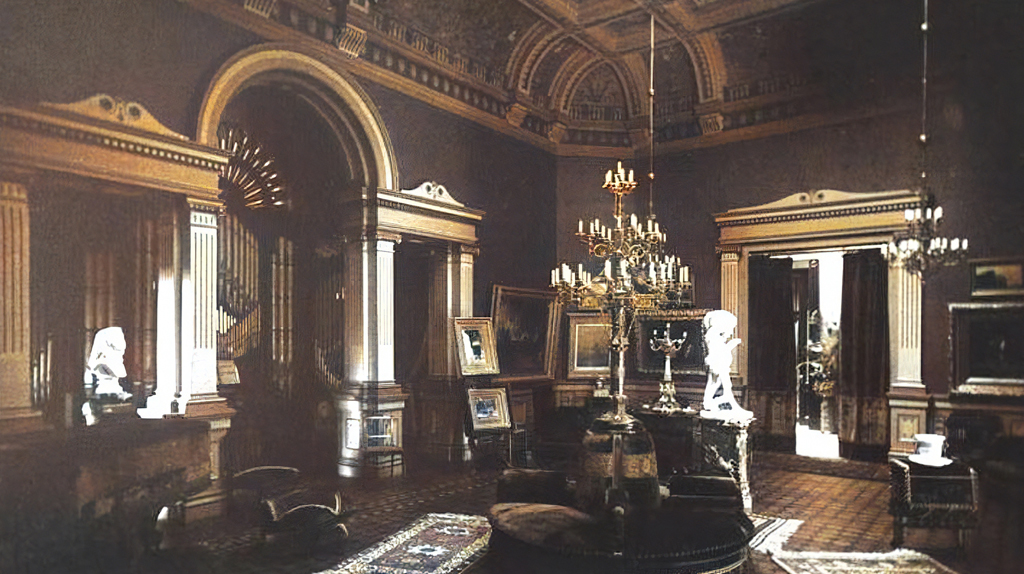
Born: March 24, 1820, Brewster, Putnam County, NY.
Died: February 12, 1915, Bridgeport, CT.
Buried: Mountain Grove Cemetery, Bridgeport, CT.
Cliff Barrows and Don Chapman discuss Fanny Crosby.
Fanny Crosby’s Voice Captured on Wax Cylinder
In a remarkable discovery in 2016, Archeophone Records unearthed the first and only known recording of legendary blind hymn writer Fanny Crosby. The wax cylinder, dating back to 1897, captures Crosby reciting her unpublished poem, “Threescore Years and Ten,” at the annual camp meeting in Ocean Grove, New Jersey. The recording was made by Manhattan optician Henry A. Heath, who used it and other recordings of prominent evangelists to continue the work of the camp meeting in his community. This rare find is part of Archeophone’s comprehensive book and CD compilation, “Waxing the Gospel: Mass Evangelism and the Phonograph, 1890-1900,” which explores the early days of recording and the convergence of tradition and technology in spreading the gospel message.
Within the humble abode of John and Mercy Crosby on March 24, 1820, a baby girl was born. Little did they know this child, Frances Jane Crosby, was destined to become one of the most prolific hymn writers in history, penning over 8,000 hymns that would draw countless souls to Christ. But first, God had some refining to do in young Fanny’s life.
At just six weeks old, Fanny caught a cold that led to inflammation and blindness in her eyes. Many would view this as a tragedy, but Fanny would later say, “It seemed intended by the blessed providence of God that I should be blind all my life, and I thank him for the dispensation. If perfect earthly sight were offered me tomorrow I would not accept it. I might not have sung hymns to the praise of God if I had been distracted by the beautiful and interesting things about me.”
Fanny’s Early Poetic Gift and Education
As a child, Fanny developed a love for poetry. She would memorize long passages of Scripture and spend hours creating her own poems. Her talent soon caught the attention of a prestigious school, the New York Institute for the Blind, where she excelled as a student and eventually joined the faculty. But God had plans to use Fanny’s gift of poetry for His glory in a unique way.
In 1851, Fanny met George Root, a composer of popular songs. Though she had previously only written sacred poetry, Fanny began collaborating with Root to write secular music, and together they penned dozens of popular songs. But something was still missing in Fanny’s spiritual life. She attended church regularly but lacked true peace with God.
Fanny Crosby’s Profound Salvation Experience
This all changed in November 1850 when Fanny, attending a revival meeting at the Thirtieth Street Methodist Church, had a profound salvation experience. She had sought peace at the altar on two previous occasions, but it wasn’t until the evening of November 20 that she felt the light must come then or never.
As Fanny later recounted, “I arose and went to the altar alone. After a prayer was offered, they began to sing the grand old consecration hymn, ‘Alas, and did my Savior bleed, And did my Sovereign die?’ And when they reached the third line of the fourth stanza, ‘Here Lord, I give myself away,’ my very soul was flooded with a celestial light. I sprang to my feet, shouting ‘hallelujah,’ and then for the first time I realized that I had been trying to hold the world in one hand and the Lord in the other.”
From that point forward, Fanny determined to use her poetic gift solely for God’s glory. Her salvation experience marked a pivotal turning point in her life and set her on the path to becoming one of the most prolific and influential hymn writers in history.
Partnerships That Propelled Fanny’s Hymns Worldwide
As Fanny began writing sacred texts for prominent composers like William Bradbury and Hubert Main, her hymns started being published in popular collections. But it was her partnership with Ira Sankey, renowned evangelist DL Moody’s worship leader, that propelled “Aunt Fanny” to worldwide fame. Sankey featured many of her hymns in their crusades, allowing the Gospel message penned by the blind poetess to reach millions.
Another pivotal relationship was with Phoebe Palmer Knapp, a wealthy Methodist and admirer of Fanny’s work. Knapp frequently hosted Fanny at her mansion and collaborated on hymns, most notably writing the tune to “Blessed Assurance.” Knapp and others advocated that Crosby should receive more of the royalties and profits from her hymns, which were making her publisher very wealthy while she lived humbly. But Fanny cared little for fame and fortune.
Fanny’s God-Inspired Hymn Writing Process
Fanny’s hymn writing process was uniquely spiritual. She always began on her knees in prayer, asking God for guidance and inspiration. And God surely answered – Fanny would often compose up to seven hymns a day, all perfectly formed in her mind before dictating them to a transcriber. One wonders if her physical blindness actually sharpened her spiritual perception.
Criticism and Acclaim for Crosby’s Hymns
Though she was incredibly prolific, some in the church music establishment criticized Fanny’s hymns for being too sentimental and simplistic. One professor snidely remarked that he judged a hymnal by the lack of Crosby hymns it contained. But the masses of believers clearly disagreed. One music historian said “It seemed that the life experiences of the author and the people were dramatically entwined and for every need in life, Fanny Crosby had written a hymn that would touch that emotion or human experience.”
Fanny Crosby’s Unmatched Hymn Writing Legacy
Fanny wrote over 8,000 hymns in her lifetime, an astounding feat unrivaled by any other hymn writer. Millions of copies sold worldwide, and yet she received mere pennies per hymn and often gave even that away to those poorer than herself. She had little regard for earthly wealth, turning down opportunities to profit from her work and instead devoting herself wholeheartedly to Christian service among the poor and forgotten.
Fanny’s Unique and Challenging Marriage
Fanny’s personal life took an unconventional turn when she wed Alexander Van Alstyne, a fellow teacher at the Institute who was also blind. Their marriage faced an early test when, in 1859, their daughter Frances died in her sleep soon after birth. Some speculate it was typhoid fever or SIDS that claimed the infant’s life. The heartbreaking loss deeply affected both parents, with Fanny pouring her grief into the hymn “Safe in the Arms of Jesus.”
After losing their child, the Van Alstynes’ relationship became strained. Alexander grew increasingly reclusive, while Fanny rarely spoke of the tragedy, only mentioning to close friends late in life, “God gave us a tender babe but the angels came down and took our infant up to God and to His throne.”
The couple began to move frequently, never putting down roots or owning a home. By 1880, a rift of unknown origin led them to separate, living independently while still occasionally ministering together in public. It was, as some observed, “a most unusual married life.” Through it all, Fanny leaned on her faith. Rather than becoming embittered, she allowed her suffering to deepen her compassion and empathy for others.
Aunt Fanny: Passionate Rescue Mission Worker
Which brings us to the calling closest to Fanny’s heart in her later years: rescue mission work. More than just a hymn writer, Fanny was passionately involved in the burgeoning urban mission movement, regularly ministering at places like the Water Street and Bowery Missions to alcoholics and the desperately poor. She was also a staunch supporter of women’s ministries and temperance unions.
At age 60, Fanny rededicated her life to serving Christ among the poor and downtrodden. For the next three decades, she was a tireless advocate, reciting poems at rescue mission services, conversing one-on-one with the homeless and addicted, always seeing the immense value in every lost soul. It was her life’s delight to, as she put it, “open my hand wide to those who needed assistance.”
Fanny Crosby’s Vibrant Final Years and Homegoing

As Fanny entered her final years, now living with her half-sister in Connecticut, she remained sharp in mind and passionate in spirit, even as her body weakened. When she spoke to 5,000 people at a Carnegie Hall evangelistic meeting in 1911, many remarked that her voice still rang with conviction. Friends like Ira Sankey passed away, but her faith remained vibrant. The kingdom work always continued. (Fanny is pictured in 1906.)
Then on February 12, 1915, at age 94, Fanny Crosby passed from this world she could not see into the loving arms of her Savior. Her tombstone bore the simple epitaph: “Aunt Fanny: She hath done what she could.” Indeed this blind, humble servant had given her all to further the Gospel and bring glory to God. The “Queen of Gospel Song Writers” was home at last.
Fanny Crosby’s Eternal Legacy
No doubt she was greeted by a chorus of souls who were now sharing in the blessed assurance of heaven because they had heard and responded to the message in a Fanny Crosby hymn. More like Jesus, safe in His arms, redeemed and free at last – all because God chose to shine His light through the surrendered pen of a little blind girl.
Fanny had set an audacious goal of winning a million souls to Christ through her hymns. With each hymn she penned, she earnestly prayed that it would be used by God to draw men and women to salvation. Ever the faithful steward, she diligently kept records of those reportedly saved through her musical ministry.
While only heaven knows the full impact of her work, there is no doubt that multitudes came to faith by hearing the Gospel message woven throughout Fanny Crosby’s more than 8,000 hymns. Her legacy continues even now, as her timeless lyrics still stir hearts to respond to God’s call. Fanny’s single-minded desire to bring glory to Christ, her lifelong love for Scripture, and her deep compassion for the lost, all poured out through her poetry, have left an eternal imprint on the church and the world. Truly, Fanny’s hymns will be sung until that glorious day when all the redeemed gather around the throne to sing of God’s love forevermore.


